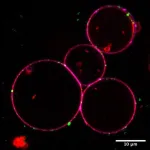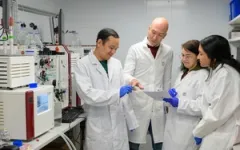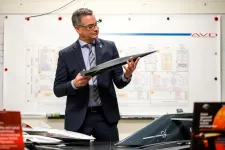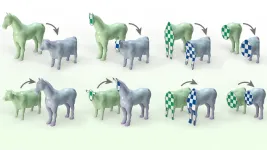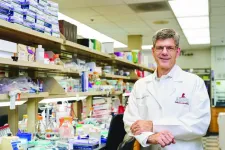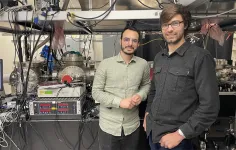(Press-News.org) To prevent our body’s cells from overflowing with garbage and to keep them healthy, the waste inside them is constantly being disposed of. This cleaning process is called autophagy. Scientists have now, for the first time, rebuilt the complex nanomachine in the laboratory that starts this process – and it works quite differently from other cellular machines. The researchers’ new insights could help open up new approaches for the treatment of cancer, immune disorders, and neurodegenerative diseases in the future, and possibly even delay aging.
Have you ever put off cleaning the house or decluttering the overflowing basement? Living cells cannot afford this procrastination when it comes to clearing the decks. Tiny garbage chutes are constantly active there to capture worn-out proteins, faulty cell components, or defective organelles. These garbage chutes, called autophagosomes, pick out the discarded components before they accumulate in the cell and cause damage. The cellular waste is then passed on to the cell’s own recycling machinery, the lysosome, where it is digested and recycled. Thus, building blocks for new cellular components are quickly available again. The autophagy process, literally self-eating, thus also helps cells to survive stress or periods of starvation.
Autophagy also serves another important purpose. It renders harmless viruses and bacteria that successfully bypass the immune system’s defenses and reach the cell plasma. The consequences are correspondingly fatal if the autophagy process is faulty, too slow, or too fast. Neurodegenerative diseases and cancer can develop or disorders of the immune system may occur. Aging processes also appear to accelerate.
“Autophagy is a highly complex process involving many different proteins and protein complexes. We know many of them, but there are still fundamental gaps in our knowledge,” reports Alex Faesen, research group leader at the Max Planck Institute for Multidisciplinary Sciences in Göttingen. “How do the protein components work together? How is the process of autophagy started and stopped? When and where is the autophagosome assembled? That is what we want to find out.”
Nanomachine at work
His team has now succeeded, for the first time, in producing all the proteins involved in the autophagy process in the laboratory and observing them directly as the autophagosomes assemble. This was a mammoth task for the entire research group, taking several years, for which they cooperated with the teams led by Björn Stork from the University of Düsseldorf and Michael Meinecke, previously at the University Medical Center Göttingen now at the Heidelberg University Biochemistry Center. “There were many challenges,” recalls Faesen. In the first step, the scientists produced each individual protein component in the laboratory. The standard approach is to use bacteria that are genetically reprogrammed to produce the desired protein in large quantities. “But protein production with bacteria did not work for any of our proteins,” the Göttingen biochemist says. Instead, the researchers switched to insect cells as molecular helpers – the breakthrough.
In the next step, the team brought the individual protein complexes together. “The complexes self-assembled into a protein supercomplex, the autophagy initiation complex. In fact, autophagy involves a sophisticated cellular nanomachine – and it works quite differently than previously thought,” the group leader says.
To make autophagosomes, the autophagy initiation complex first creates a junction between a particular structure of the cell, the endoplasmic reticulum, and the autophagosome that forms. Under stress or in times of starvation, such as during endurance sports, this occurs within just a few minutes. “From this point on, there is no turning back: The waste disposal is assembled and collects the cellular waste,” explains Anh Nguyen, one of the two first authors of the study. Co-first author Fancesca Lugarini adds, “Via the contact site, fat-like molecules called lipids are transported to a precursor stage of autophagosomes, where they are incorporated.” These grow and, in the process, enclose the cell material to be disposed of – the finished mini-organelle is formed. Within barely 20 minutes of its formation, the autophagosome is already delivering its waste to the lysosome by fusing with it.
Protein origami for “on” and “off”
But what starts the assembly of the autophagy machine, what starts it and what stops it? The researchers did not find a molecular “on” and “off” switch as in other molecular machines. Instead, the switch uses a highly unusual behavior of proteins: metamorphosis. ” Certain molecules, called ATG13 and ATG101, have the ability to fold in different 3D structures, thereby changing its ability to bind to proteins in the machine. “This protein metamorphosis also gives the go-ahead for the assembly of the autophagy initiation complex at the right time and in the right place,” says Faesen, describing the special features of the nanomachine. Without metamorphosis, the initiation machine does not assemble.
The scientists hope that the new findings will advance the development of future drugs that can be used to treat diseases that are based on a faulty autophagy process.
END
A look into the heart of cellular waste disposal
Researchers reveal how a nanomachine takes care of cleaning up inside the cell
2023-05-24
ELSE PRESS RELEASES FROM THIS DATE:
Designing a next generation hypersonic demonstrator
2023-05-24
Today, large commercial jets fly around 580 mph. The Lockheed SR-71 Blackbird introduced in 1966 is the fastest supersonic jet vehicle in the world, reaching speeds of more than 2,200 mph, nearly four times faster than a commercial jet.
The fastest rocket-powered hypersonic vehicle developed in the late 1960s carrying a human has been the North American X-15, reaching a top speed of 4,520 mph, twice that of the SR-71.
Recently, the U.S. Air Force has awarded a contract to engineer Project Mayhem with the goal to reach 4,603 mph. Now, imagine a vehicle that could fly much faster, maybe even above 6,905 mph, which is beyond nine times the speed of sound.
The University of Texas at Arlington’s ...
Confusion over VAERS: Why the vaccine safety reporting system should be renamed
2023-05-24
PHILADELPHIA – The federal health system for reporting “adverse events” after vaccination, known as VAERS, is designed to assist in the early detection of complications and responsive action. But when the pandemic and advent of new vaccines for Covid-19 turned a spotlight on this formerly little-known system, the flood of web and social media references to it was accompanied by confusion about what the system is and what the reports in it signify.
A new report from the Annenberg Public Policy Center examines misconceptions about the government’s Vaccine Adverse ...
A better way to match 3D volumes
2023-05-24
CAMBRIDGE, MA — In computer graphics and computer-aided design (CAD), 3D objects are often represented by the contours of their outer surfaces. Computers store these shapes as “thin shells,” which model the contours of the skin of an animated character but not the flesh underneath.
This modeling decision makes it efficient to store and manipulate 3D shapes, but it can lead to unexpected artifacts. An animated character’s hand, for example, might crumple when bending its fingers — a motion that resembles how an empty rubber glove deforms rather than the motion of a hand filled with bones, tendons, ...
Chemical Insights Research Institute and the Campus Safety, Health, and Environmental Management Association publish guidance for the safe use of 3D printing in institutions of higher education
2023-05-24
Atlanta (May 24, 2023) - Chemical Insights Research Institute (CIRI) of UL Research Institutes and the Campus Safety, Health, and Environmental Management Association (CSHEMA), announce the publication of, “UL 200B: Guidance Document for Safe Use of 3D Printing for Institutions of Higher Education.”
The availability of 3D printing has fostered creative and innovative learning experiences for many within the large population of students in higher education. There are roughly 17.3 million undergraduates in the U.S. alone. Because 3D printers are affordable compact, and user friendly, they can ...
SWI/SNF complexes “bookmark” cell identity during division
2023-05-24
(Memphis, Tenn.—May 24, 2023) When a cell divides, it retains information about how to grow and instructions about what type of cell to become. Scientists at St. Jude Children’s Research Hospital have gained a new understanding of how these processes can work, revealing a previously unappreciated role for the SWI/SNF chromatin remodeling complex. The study was published today in Nature.
When a cell undergoes differentiation, stem cells (the earliest cells that develop) undergo changes that transform them into a different type of cell, typically one with a more specialized function (such as a skin or muscle cell). As ...
Watching molecules relax in real time
2023-05-24
– By Rachel Berkowitz
Designing the next generation of efficient energy conversion devices for powering our electronics and heating our homes requires a detailed understanding of how molecules move and vibrate while undergoing light-induced chemical reactions. Researchers at the Department of Energy’s Lawrence Berkeley National Laboratory (Berkeley Lab) have now visualized the distortions of chemical bonds in a methane molecule after it absorbs light, loses an electron, and then relaxes. Their study provides insights into how molecules react to light, which can ultimately be useful for developing new methods ...
Announcing the Johnson & Johnson nursing innovation fellows
2023-05-24
PHILADELPHIA (May 24, 2023) – The University of Pennsylvania School of Nursing is pleased to announce that ten teams from health systems around the country have been selected for the Johnson & Johnson Nurse Innovation Fellowship Program (JJNIF), powered by Penn Nursing and the Wharton School–a ground-breaking, one-year, team-based nursing fellowship for Chief Nursing Officers, nurse executives, and senior nurse leaders.
The fellowship is unique in that two nurse leaders – one Chief Nursing Officer or nurse executive and one other senior ...
Tambourine announces the ALS breakthrough research fund, releases inaugural request for proposals
2023-05-24
Washington, DC (May 24) – Tambourine, in partnership with the Milken Institute Center for Strategic Philanthropy, today announced the ALS Breakthrough Research Fund and released the Fund’s first Request for Proposals (RFP). The Fund seeks to change how we understand and treat amyotrophic lateral sclerosis (ALS) by supporting innovative basic and discovery-focused research around the world. It particularly focuses on soliciting and funding creative, high-risk, high-reward ideas that might not otherwise fit existing grant programs but hold the potential to ...
MD Anderson Research Highlights for May 24, 2023
2023-05-24
HOUSTON ― The University of Texas MD Anderson Cancer Center’s Research Highlights showcases the latest breakthroughs in cancer care, research and prevention. These advances are made possible through seamless collaboration between MD Anderson’s world-leading clinicians and scientists, bringing discoveries from the lab to the clinic and back.
Recent developments include a new treatment option for relapsed/refractory mantle cell lymphoma, a better understanding of protein variants that trigger tumor cell death and activate ...
Study finds daily multivitamin supplements improved memory and slowed cognitive aging in older adults
2023-05-24
Few effective strategies have been shown in randomized clinical trials to improve memory or slow cognitive decline among older adults. Nutritional interventions may play an important role because the brain requires several nutrients for optimal health, and deficiencies in one or more of these nutrients may accelerate cognitive decline. The COcoa Supplement and Multivitamin Outcomes Study (COSMOS), a large-scale nation-wide randomized trial directed by researchers at Brigham and Women’s Hospital (BWH), a founding member of Mass General Brigham, included two separate clinical trials ...
LAST 30 PRESS RELEASES:
Eye for trouble: Automated counting for chromosome issues under the microscope
The vast majority of US rivers lack any protections from human activities, new research finds
Ultrasound-responsive in situ antigen "nanocatchers" open a new paradigm for personalized tumor immunotherapy
Environmental “superbugs” in our rivers and soils: new one health review warns of growing antimicrobial resistance crisis
Triple threat in greenhouse farming: how heavy metals, microplastics, and antibiotic resistance genes unite to challenge sustainable food production
Earthworms turn manure into a powerful tool against antibiotic resistance
AI turns water into an early warning network for hidden biological pollutants
Hidden hotspots on “green” plastics: biodegradable and conventional plastics shape very different antibiotic resistance risks in river microbiomes
Engineered biochar enzyme system clears toxic phenolic acids and restores pepper seed germination in continuous cropping soils
Retail therapy fail? Online shopping linked to stress, says study
How well-meaning allies can increase stress for marginalized people
Commercially viable biomanufacturing: designer yeast turns sugar into lucrative chemical 3-HP
Control valve discovered in gut’s plumbing system
George Mason University leads phase 2 clinical trial for pill to help maintain weight loss after GLP-1s
Hop to it: research from Shedd Aquarium tracks conch movement to set new conservation guidance
Weight loss drugs and bariatric surgery improve the body’s fat ‘balance:’ study
The Age of Fishes began with mass death
TB harnesses part of immune defense system to cause infection
Important new source of oxidation in the atmosphere found
A tug-of-war explains a decades-old question about how bacteria swim
Strengthened immune defense against cancer
Engineering the development of the pancreas
The Journal of Nuclear Medicine ahead-of-print tip sheet: Jan. 9, 2026
Mount Sinai researchers help create largest immune cell atlas of bone marrow in multiple myeloma patients
Why it is so hard to get started on an unpleasant task: Scientists identify a “motivation brake”
Body composition changes after bariatric surgery or treatment with GLP-1 receptor agonists
Targeted regulation of abortion providers laws and pregnancies conceived through fertility treatment
Press registration is now open for the 2026 ACMG Annual Clinical Genetics Meeting
Understanding sex-based differences and the role of bone morphogenetic protein signaling in Alzheimer’s disease
Breakthrough in thin-film electrolytes pushes solid oxide fuel cells forward
[Press-News.org] A look into the heart of cellular waste disposalResearchers reveal how a nanomachine takes care of cleaning up inside the cell
